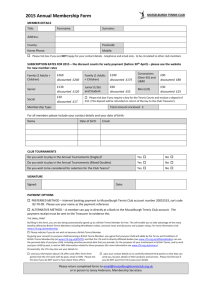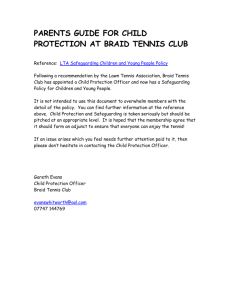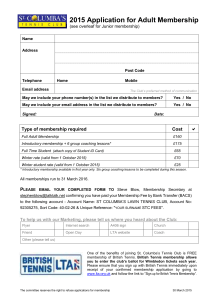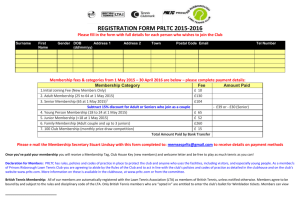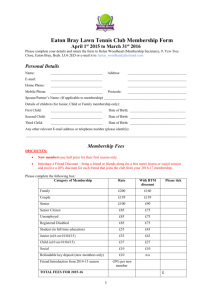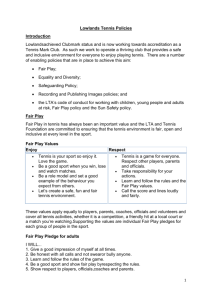Section 3 – Policies and procedures
advertisement
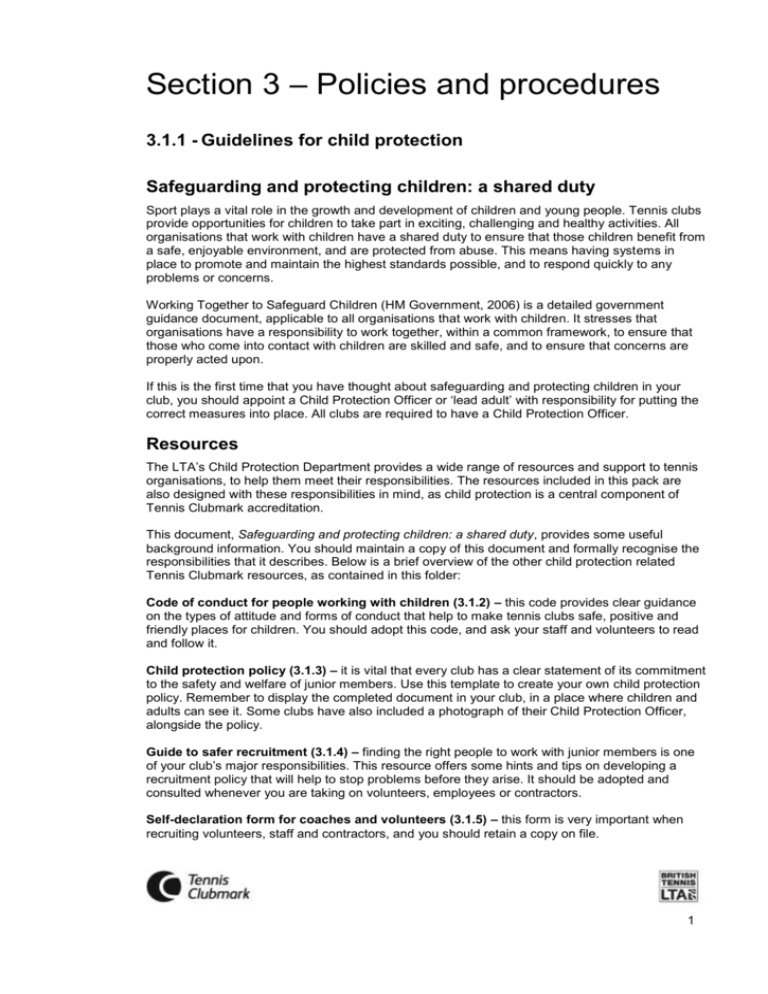
Section 3 – Policies and procedures 3.1.1 - Guidelines for child protection Safeguarding and protecting children: a shared duty Sport plays a vital role in the growth and development of children and young people. Tennis clubs provide opportunities for children to take part in exciting, challenging and healthy activities. All organisations that work with children have a shared duty to ensure that those children benefit from a safe, enjoyable environment, and are protected from abuse. This means having systems in place to promote and maintain the highest standards possible, and to respond quickly to any problems or concerns. Working Together to Safeguard Children (HM Government, 2006) is a detailed government guidance document, applicable to all organisations that work with children. It stresses that organisations have a responsibility to work together, within a common framework, to ensure that those who come into contact with children are skilled and safe, and to ensure that concerns are properly acted upon. If this is the first time that you have thought about safeguarding and protecting children in your club, you should appoint a Child Protection Officer or ‘lead adult’ with responsibility for putting the correct measures into place. All clubs are required to have a Child Protection Officer. Resources The LTA’s Child Protection Department provides a wide range of resources and support to tennis organisations, to help them meet their responsibilities. The resources included in this pack are also designed with these responsibilities in mind, as child protection is a central component of Tennis Clubmark accreditation. This document, Safeguarding and protecting children: a shared duty, provides some useful background information. You should maintain a copy of this document and formally recognise the responsibilities that it describes. Below is a brief overview of the other child protection related Tennis Clubmark resources, as contained in this folder: Code of conduct for people working with children (3.1.2) – this code provides clear guidance on the types of attitude and forms of conduct that help to make tennis clubs safe, positive and friendly places for children. You should adopt this code, and ask your staff and volunteers to read and follow it. Child protection policy (3.1.3) – it is vital that every club has a clear statement of its commitment to the safety and welfare of junior members. Use this template to create your own child protection policy. Remember to display the completed document in your club, in a place where children and adults can see it. Some clubs have also included a photograph of their Child Protection Officer, alongside the policy. Guide to safer recruitment (3.1.4) – finding the right people to work with junior members is one of your club’s major responsibilities. This resource offers some hints and tips on developing a recruitment policy that will help to stop problems before they arise. It should be adopted and consulted whenever you are taking on volunteers, employees or contractors. Self-declaration form for coaches and volunteers (3.1.5) – this form is very important when recruiting volunteers, staff and contractors, and you should retain a copy on file. 1 Policy on the use of images of children and young people (3.1.6) – this guidance document covers the safe and appropriate use of films and photographs of children under 18. It includes a sample consent form, which should be completed (wherever possible) before any filming or photography takes place. Remember to contact LTA Child Protection if you need advice on adopting these guidelines or require help putting together a consent form for a specific event. Guidelines for travelling and staying away (3.1.8) – taking players on trips is a complex issue that requires careful planning. This guidance document outlines all the major considerations, including transport, supervision, medical emergencies, nutrition and codes of conduct. It also covers what to do if child safety concerns arise, and includes a comprehensive checklist for away fixtures and overnight stays. Junior club membership form (3.1.9) – this template will make sure you gather the basic information that you need in order to look after your junior members properly. You can also use this form to collect information that will be useful in developing your facilities and services, as well as your marketing activities. Remember to tailor the template to the specific needs of your club, by including questions that have direct relevance to your projects, activities and goals. Trip and activity consent form (3.1.10) – to be completed by parent(s)/guardian(s) whenever children and young adults are taken on trips or to special events. Incident report form (3.1.11) – your Child Protection Officer and senior club officials should have easy access to this form. Use it to report any concerns or incidents in which a child’s safety or welfare was placed at risk. Remember to get expert advice immediately (by telephone) from your county LTA or national LTA Child Protection, if you feel it is necessary. This form is not a requirement for referrals, but you may be asked to complete one to support the Child Protection Department in its work. Safeguarding and protecting: what’s the difference? ‘Safeguarding’ is the word that applies to all the work a club does to provide a safe, positive and friendly environment for children. The code of conduct provided in this pack encourages attitudes and approaches that help to safeguard children. By adopting an open, accountable and responsible approach, clubs can help to prevent problems before they occur. Measures such as safe recruitment, clear standards of conduct, and careful planning for photography, events and travel, also contribute to a safe, high quality environment for junior members. In summary, safeguarding is the ‘behind the scenes’ work that well-organised clubs do to prevent problems from arising. ‘Protecting’ refers to the procedures that come into force when there is a particular concern or incident. Good safeguarding helps to reduce the need for protection, but it is vital to have rigorous and clear procedures in place in case a problem arises. If a child suggests that they are being abused, or if an adult reports abuse or bad practice that could put a child’s welfare at risk, these procedures must be understood and followed by everyone involved. By appointing a Child Protection Officer who can liaise with county LTA or national LTA Child Protection, you establish an important safety net. The HITLIST gives some important advice for CPOs. Of course, safeguarding and protecting often overlap. By using the resources in this folder and others provided by the LTA, and by accessing the training required as part of Tennis Clubmark accreditation, you will be adding to your knowledge and understanding in both areas. The better you are at developing a safe and positive club for junior members, the easier you will find it to identify when things are going wrong and to deal with them appropriately. Remember, LTA Child Protection is able to offer you a wide range of advice and support. 2 Recognising signs of abuse Most of your work as a club should focus on tennis. The safeguarding measures suggested here (and in other LTA guidance documents) are mainly intended to help you deliver tennis in a safe environment. This will help young people to feel supported, and ensure that most problems are tackled before they become serious. Even so, it is extremely important that you are aware of the different forms of child abuse, and of the possible signs that abuse is occurring. Although this should not be the main focus of your safeguarding and protection measures, you could prevent a child from coming to harm if you have some basic knowledge in this area. The best way to gain basic skills in recognising signs of abuse is to attend the LTA/UKCC child protection workshop. Tennis Clubmark requires your club to send two people on this course, including your club coach. However, as an introduction, please be aware of the following descriptions of different types of abuse, taken from Working Together to Safeguard Children (HM Government, 2006): What is abuse and neglect? – abuse and neglect are forms of maltreatment of a child. Somebody may abuse or neglect a child by inflicting harm, or by failing to act to prevent harm. Children may be abused in a family or in an institutional or community setting; by those known to them or, more rarely, by a stranger. They may be abused by an adult or adults or another child or children. Physical abuse – physical abuse may involve hitting, shaking, throwing, poisoning, burning or scalding, drowning, suffocating, or otherwise causing physical harm to a child. Physical harm may also be caused when a parent or carer fabricates the symptoms of, or deliberately induces illness in a child. Emotional abuse – emotional abuse is the persistent emotional maltreatment of a child such as to cause severe and persistent adverse effects on the child’s emotional development. It may involve conveying to children that they are worthless or unloved, inadequate, or valued only insofar as they meet the needs of another person. It may feature age or developmentally inappropriate expectations being imposed on children. These may include interactions that are beyond the child’s developmental capability, as well as overprotection and limitation of exploration and learning, or preventing the child participating in normal social interaction. It may involve seeing or hearing the ill-treatment of another. It may involve serious bullying causing children frequently to feel frightened or in danger, or the exploitation or corruption of children. Some level of emotional abuse is involved in all types of maltreatment of a child, though it may occur alone. Sexual abuse – sexual abuse involves forcing or enticing a child or young person to take part in sexual activities, including prostitution, whether or not the child is aware of what is happening. The activities may involve physical contact, including penetrative (e.g. rape, buggery or oral sex) or non-penetrative acts. They may include non-contact activities, such as involving children in looking at, or in the production of, pornographic material or watching sexual activities, or encouraging children to behave in sexually inappropriate ways. Neglect – neglect is the persistent failure to meet a child’s basic physical and/or psychological needs, likely to result in the serious impairment of the child’s health or development. Neglect may occur during pregnancy as a result of maternal substance abuse. Once a child is born, neglect may involve a parent or carer failing to provide adequate food and clothing, shelter including exclusion from home or abandonment, failing to protect a child from physical and emotional harm or danger, failure to ensure adequate supervision including the use of inadequate care-takers, or the failure to ensure access to appropriate medical care or treatment. It may also include neglect of, or unresponsiveness to, a child’s basic emotional needs. 3 Bullying – bullying may be defined as deliberately hurtful behaviour, usually repeated over a period of time, where it is difficult for those bullied to defend themselves. It can take many forms, but the three main types are physical (e.g. hitting, kicking, theft), verbal (e.g. racist or homophobic remarks, threats, name calling) and emotional (e.g. isolating an individual from the activities and social acceptance of their peer group). The damage inflicted by bullying can frequently be underestimated. It can cause considerable distress to children, to the extent that it affects their health and development or, at the extreme, causes them significant harm (including self-harm). All settings in which children are provided with services or are living away from home should have in place rigorously enforced anti-bullying strategies. Responding to a concern It can be very difficult to identify that abuse or neglect is occurring, or that someone’s poor conduct is having a serious impact on a child. It’s not always a question of identifying the visible signs of abuse; often, a child or adult speaking out raises concerns. Children may not be able to give a clear explanation of what has happened, but will indicate that something is wrong. It is not your responsibility to investigate or intervene, but it is your responsibility to listen and to make sure that the child receives all the necessary help and support. Here are five simple steps that you should take if someone reports a concern to you: 1. Stay calm and assure the child. 2. It takes a lot of courage for a child to disclose a problem, and he/she usually wants you to help. Therefore, you should not make promises of confidentiality, but be clear that you may have to contact other people who will be able to help. 3. Listen carefully to what the child says and do not suggest ideas. Keep questioning to a minimum, use open questions, and record the conversation as soon as you can. Record precise words and phrases (as closely as possible) and be clear to make a distinction between fact and opinion. 4. Report the concern to the Child Protection Officer in your club, or go directly to the county/national LTA. Do not hesitate to call national LTA Child Protection if you need urgent advice. LTA Child Protection contact details are given below. If you fear that a child is at immediate risk, and you cannot get advice from a Child Protection Officer, you should contact your local police or social services. 5. Do not discuss the concerns with others until you have reported them, as above. A club or county officer might contact LTA Child Protection, if they feel the problem is serious, and it is possible that the police and/or social services may then become involved. It is not your responsibility to make these decisions; the correct course of action is for you to report the concern, as quickly and accurately as you can. Good practice and support – the Tennis Clubmark folder offers a variety of resources to help you ensure that tennis is a safe sport for children and young people. If you have any comments or questions about the issues raised in these guidelines, of if you need further and more detailed advice, you should contact LTA Child Protection. Remember to regularly check the website for new resources and updated materials. LTA Child Protection T: 0208 487 7008/7116 M (24 hour): 07971 141 024 E: childprotection@lta.org.uk www.LTA.org.uk/childprotection 4 Section 3 – Policies and procedures 3.1.2 - Code of conduct for people working with children Children and young people are able to play tennis because of the thousands of adults, both paid and unpaid, who provide opportunities for them to do so. All of these adults have special responsibilities to the children they work with. This code of conduct provides clear guidance on the types of practice that will meet these responsibilities. Good conduct not only prevents incidents and allegations, but also helps to highlight any conduct (by other people) that is unsafe or unprofessional. This code of conduct can be adopted or used by any tennis organisation and is in place at Old College Tennis & Croquet Club. The LTA Child Protection Department offers advice on this. Some people, such as LTA Licensed Coaches and ABTO recognised tennis officials, are already required to follow codes of conduct applying to their positions. Those working with children in tennis should: 1. Be professional and maintain the highest standards of personal behaviour at all times. 2. Recognise the trust placed in adults by children, and recognise the power held over children by adults. Treat this trust and this power with the highest responsibility. 3. Try to work in an open and accountable manner at all times. Work in view of others wherever possible, be wary of working alone and unobserved, and be willing to accept questions or criticism regarding good practice. 4. Expect others to work in an open and accountable manner. Question and criticise the practice of others if necessary. 5. Maintain a professional relationship with children. Any form of sexual relationship or activity with a child is unacceptable and could lead to disciplinary or legal action. 6. Not be under the influence of drink, drugs or any illegal substance. 7. Use appropriate and respectful forms of discipline and communication. Physical aggression, intimidation, verbal abuse and persistent shouting are not acceptable. Any form of assault (e.g. hitting, kicking, pinching, slapping) should be regarded as a serious incident. 8. Use appropriate language. Don’t swear, and never make sexual or suggestive comments to a child. If a child makes such comments, be prepared to enforce these boundaries in your response. 9. Not appear to favour one child or show interest in one child more than another. 10. Not discriminate against a child because of their age, gender, disability, culture, language, racial origin, religious belief or sexual identity. 5 11. Use physical contact with players only where necessary. If contact is necessary, (e.g. for the purposes of coaching or first-aid), then explain to the child what the contact is for, and change your approach if he or she appears uncomfortable. 12. Design and use training methods and training programmes that are appropriate to the individual child. 13. Be aware of situations that could be misunderstood or manipulated by other adults. For example, if a coach or official is alone with a child in a clubhouse, changing room or car, he or she may be vulnerable to allegations of misconduct. 14. Be vigilant and aware of how actions can be misinterpreted by children. Actions made with good intentions can seem intrusive or intimidating to some children. Sometimes children become attracted to the adults working with them. Adults should be aware of the impact of their actions, and should sensitively address any misunderstanding. If a concern about a child’s welfare comes to your attention: 15. Take seriously any suspicion or allegation of abuse, or any disclosure of concern made by a child (or adult). 16. If a concern comes to your attention, record information, including relevant details. Be sure to record opinions or feelings as such; do not record them as facts. Do not question or interview the people involved in the incident of concern. 17. Report any concerns within the area of Child Protection (physical, emotional or sexual abuse, neglect or bullying), in confidence and without delay, to your club, county or LTA Child Protection Officer. If CPOs cannot be contacted and there appears to be an immediate risk, contact the police or your local social services. 18. Never discuss an allegation or suspicion with another person, (other than the police or social services), before receiving advice from the club, county or LTA Child Protection Officer. Remember that it is the responsibility of all adults to safeguard children in sport. By recognising, following and discussing the principles behind this code, you are helping to make bad practice and abuse unwelcome in tennis. For more information on issues like these, see the range of guidance resources produced by the LTA Child Protection Department. Go to www.lta.org.uk/childprotection, or contact the department directly using the details below. LTA Child Protection T: 0208 487 7008/7116 M (24 hour): 07971 141 024 E: childprotection@lta.org.uk www.LTA.org.uk/childprotection 6 Section 3 – Policies and procedures 3.1.3 - Child protection policy Old College Tennis & Croquet Club aims to create an enjoyable environment for all juniors who wish to take part in tennis or other sport and social activities at the club. We believe that children and young people have the right to be safe, secure and free from threat. We believe that young people have the right to be treated with respect, and to have their concerns listened to and acted upon. We will ensure that the club provides for the needs of junior members through specific programmes, designated facilities, and safe practice. We have procedures in place to address poor practice, and to help any young person who appears to be at risk, or who appears to be the victim of abuse. We will offer help and support when a child or young person tells us that they are affected by these issues. We will take steps to ensure that any club volunteers or professionals working with children are suitable to do so, through the use of references and background checks. We will ensure that all relevant people have been vetted and approved through the LTA’s Criminal Record Bureau disclosure process. We will ensure that all of those working with children are made aware of the LTA code of conduct for people working with children in tennis, and are required to follow it. The club has an adult member who is specifically responsible for children, young people and child protection: This person’s name is: Charles Tyndale Biscoe They can be contacted at: 0208 670 4607 charlesbiscoe@live.co.uk This person’s name is: Caroline Periton They can be contacted at: the Clubhouse LTA Child Protection T: 0208 487 7008/7116 M (24 hour): 07971 141 024 E: childprotection@lta.org.uk www.LTA.org.uk/childprotection 7 Section 3 – Policies and procedures 3.1.6 - Policy on the use of images of children and young people (under the age of 18) The photography and filming of children: why it matters The main concerns addressed by these guidelines relate to: The possible identification of children when a photograph is accompanied by personal information. The inappropriate use, adaptation or copying of images for use on child pornography websites. The taking of inappropriate photographs or recorded images of children. The breach of court orders restricting photography of specific children. There have been concerns about the risks posed directly and indirectly to children and young people through the use of photographs on sport web sites and other publications when they are accompanied by personal information. This information can make a child vulnerable to an individual who may wish to ‘groom’ that child for abuse. Secondly, photographs can be adapted for inappropriate use. There is evidence of adapted material finding its way onto child pornography sites. Guidelines for recording images All children featured in recordings must be appropriately dressed, with outer clothing garments covering their torso from at least the bottom of their neck to their thighs (i.e. a minimum of vest/shirt and shorts). The photograph should ideally focus on the activity. Where possible, images of children/young people should be recorded in small groups (the group may comprise any combination of adults and children). You should ensure that images of a young person are not recorded and published where a court order prohibits this. Any inappropriate use of photography or of images should be reported to LTA Child Protection or the police. Coaches, teachers and others can use video equipment as a legitimate coaching aid. However, tennis players and their parents/carers should be made aware that this forms part of the coaching programme, and recordings should be used, stored and destroyed with care. Guidelines for publishing images If a photograph is used, give the young person’s first name only (no surname), or avoid naming them altogether. Personal details such as email addresses, home addresses and telephone numbers should never be revealed on a website. Ask the child for permission to use their image. This ensures that they understand how their image will be used to represent the sport. A photography and filming consent form is the best way of achieving this (see below). 8 Ask for parental/carer permission to use an image of a young person. This ensures that parents/carers understand how the image of their child will be used to represent the sport. A photography and filming consent form is the best way of achieving this (see below). In order to guard against the possibility of a young person under a court order appearing on a website, the simultaneous streaming of images onto a website is not recommended. Delayed streaming can limit problems, and provides an opportunity for any necessary editing. It is recommended that you employ appropriate security on web servers, so that material can only be accessed, copied or downloaded by authorised people. Make sure that you give adequate thought to the selection of images for use in publicity materials. Give close consideration to the images of children used on websites. Simple techniques such as digital ‘watermarking’ may deter others from misusing images. Try to take photographs that represent the broad range of youngsters participating safely in tennis. Think about the gender, ethnicity, ability and age of the children you photograph and try to capture the diversity of the children you work with. Photography and film at tennis events There is evidence that some people have used sporting events as an opportunity to take inappropriate photographs and film footage of young and disabled sportspeople. You have a duty of care to ensure that this risk is minimised. By following the guidelines below, you will be taking a significant step towards this goal. If you are commissioning professional photographers or inviting the press to a tennis event, it is important to ensure they are clear about your expectations of them in relation to child protection. Provide a clear brief about what is considered appropriate in terms of content and behaviour. Issue the photographer(s) with identification, which must be worn at all times. Inform participants and parents that a photographer will be in attendance at the event and ensure they consent to both the taking and publication of films or photographs. Do not allow unsupervised access to players or one-to-one photo sessions. Do not approve/allow photo sessions outside the event or at a player’s home. Ensure that photographers are able to identify any players who have not consented to being photographed. Parents and spectators might also wish to take photographs or record their children participating at the event. If parents or other spectators are intending to photograph or video at an event, they should also be made aware of your expectations. Parents and spectators should be required to register at an event, if they wish to use photographic equipment. A range of companies now provide photography services that make professional photographs available to parents and players. These companies should know about and meet specific standards agreed with the LTA. Contact LTA Child Protection if you need to know more about the use of photography at your event. In addition: Participants and parents should be informed that, if they have concerns about inappropriate or intrusive photography, these should be reported to the event organiser or official and recorded in the same manner as any other child protection concern. 9 Event organisers should approach and challenge any person taking photographs who has not registered with them. The matter may need to be referred to the police, if the person involved continues to record images. Getting consent A sample consent form is provided below. It is important that your own consent form reflects the kind of recording that you want to arrange. You can design your own form based on this template, or obtain an easily edited ‘Word’ version of this document from LTA Child Protection. Good practice and support By following the good practice outlined in this document, you will help ensure that tennis is a safe sport for children and young people. If you have any comments or questions about the issues raised in these guidelines, you should contact LTA Child Protection for detailed advice. 10 Section 3 – Policies and procedures 3.1.11 - Child protection: incident report form Details of person making the report: Name Date Title/Position Contact numbers: Organisation name Mobile Home Work Address Email address Details of child affected: Name Contact numbers: (If same as for parent/guardian, use section below) Date of birth Mobile Home Work Address (If same as for parent/guardian, use section below) Details of parent/guardian: Name Contact numbers: Relationship to child Mobile Home Work Address 11 Details of adult of concern (person who complaint/concern is about): Name Contact numbers: Date of birth Mobile Home Work Address Please include a summary of the incident/concerns below. Please describe any action that has been taken already. Relevant paperwork and additional sheets should be indicated in the boxes provided and sent to LTA Child Protection with this form. Number of additional sheets attached: Other agencies/organisations/individuals informed: 12 Contact 1 Name and address of organisation/individual Telephone number Contact person/reference number Contact 2 Name and address of organisation/individual Telephone number Contact person/reference number When you have completed the form: Attach any background documents and send the form to the LTA Child Protection Department by email or post. Remember to telephone the Child Protection Department directly if you need advice quickly. If you believe that someone may be at immediate risk, you should contact your local police or social services department. Dial 999 if there is an emergency. Apart from the police or social services, you should not discuss this referral with anyone before taking advice from your county or LTA Child Protection officer. LTA Child Protection T: 0208 487 7008/7116 M (24 hour): 07971 141 024 F: 0208 487 7301 E: childprotection@lta.org.uk www.LTA.org.uk/childprotection 13

